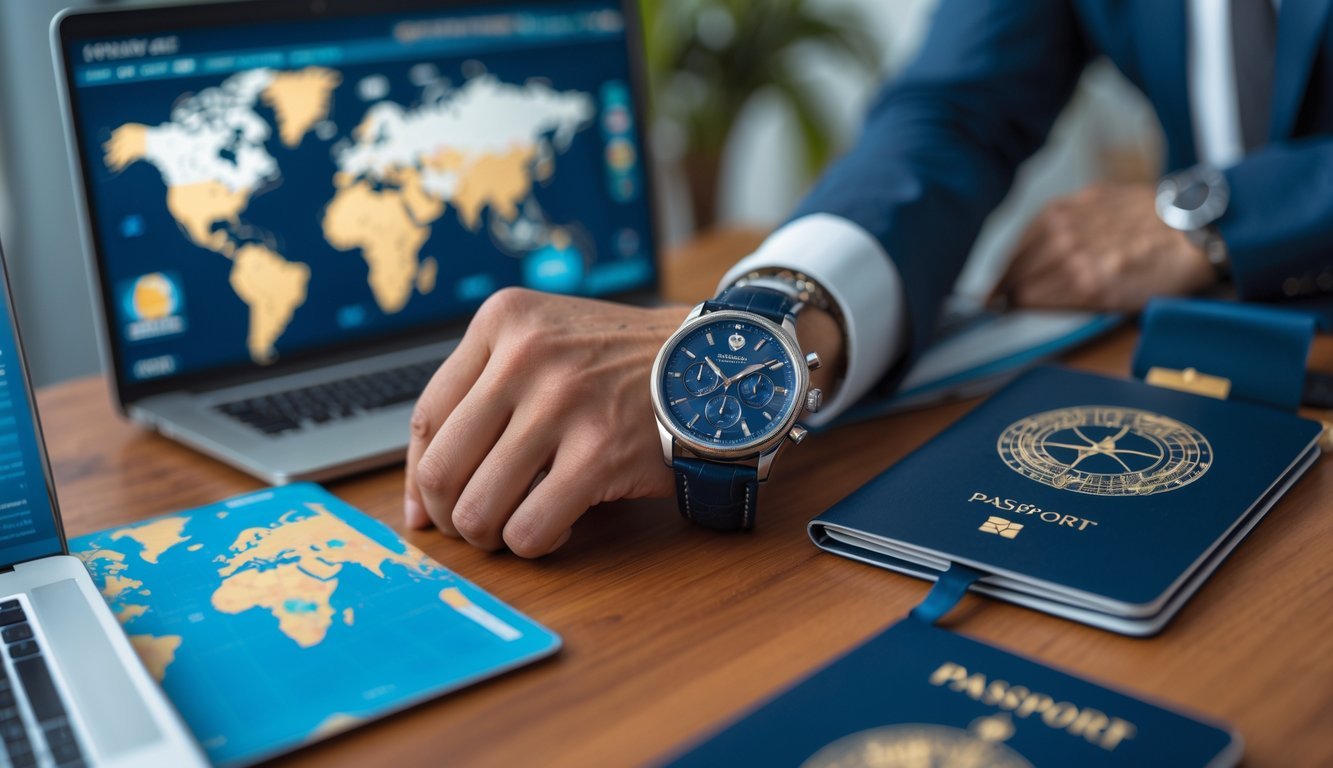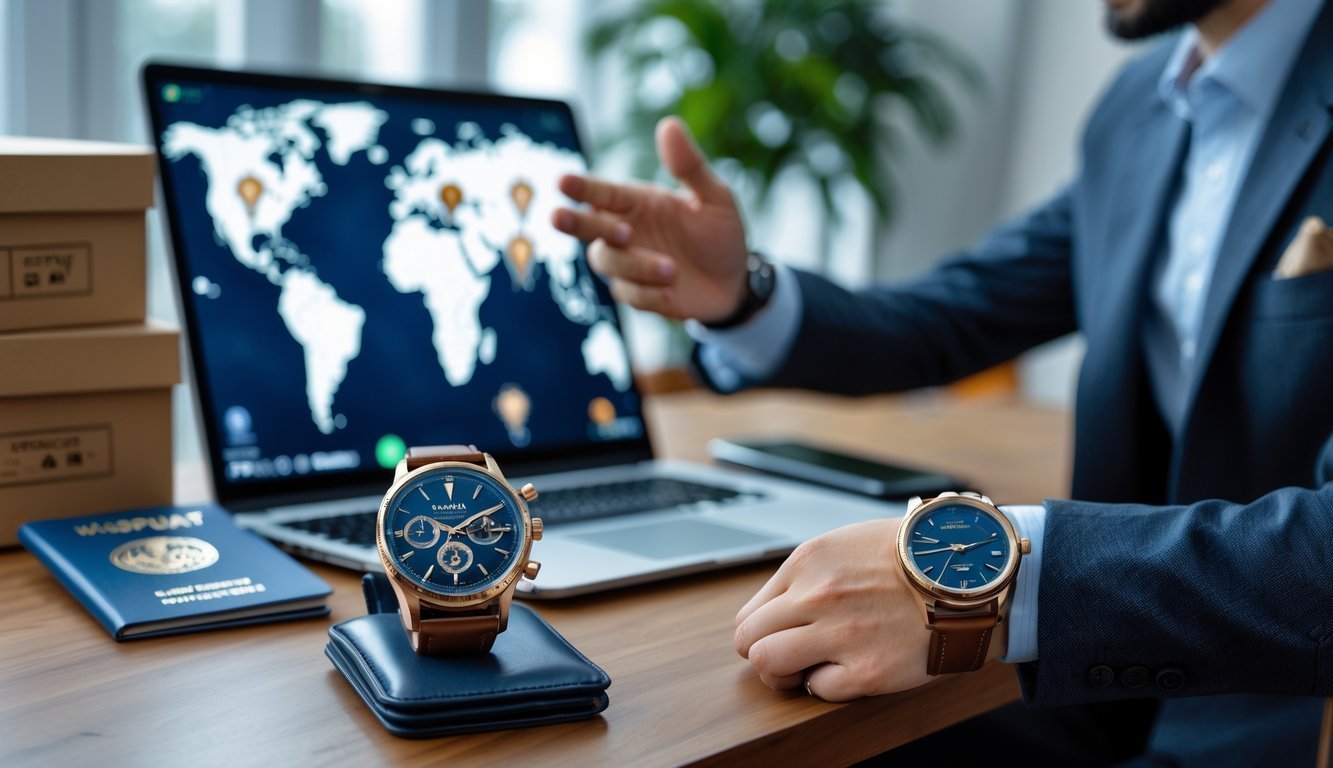Selling watches across borders opens up a world of buyers, but you need to understand international markets, shipping rules, and what buyers actually want. If you want to make money selling watches internationally, start by researching your target markets, set prices that make sense, and build trust with clear communication and reliable shipping.
You’ll run into customs rules, currency differences, and culture-based preferences, all while keeping an eye out for fraud and tricky returns.
Smart sellers stick with high-demand brands, choose trusted platforms, and always upload detailed descriptions and sharp photos.
This guide shares strategies to help you grow your watch business worldwide, from picking the best markets to boosting profits with cross-border selling.
Key Takeaways
- Research international markets and regulations before you start selling watches globally
- Build buyer trust with detailed listings, great photos, and shipping people can count on
- Focus on brands buyers want and use proven platforms to boost your international sales
Key Strategies for Selling Watches Internationally

If you want to do well in international watch sales, you really need to know your markets, do your homework, and price things right.
These basics help you build a profitable global business.
Understanding International Watch Markets
Buyers in different places like different watches and have their own shopping habits.
European buyers usually like classic styles and brands with history.
In Asia, luxury status watches and limited editions fly off the shelves.
North Americans care about features and durability.
They want water resistance, multiple time zones, and watches that can keep up with their lives.
Sports watches and smartwatches tend to do well in North America.
Popular Watch Categories by Region:
- Europe: Dress watches, vintage styles, Swiss brands
- Asia: Luxury brands, gold watches, complications
- North America: Sport watches, tool watches, everyday pieces
- Middle East: Premium brands, precious metals, exclusive models
Timing matters.
Western countries see big sales jumps in the holiday season from November to January.
Chinese New Year brings a wave of buyers in February across Asia.
Watch collecting groups shape trends in big cities.
They can boost demand for certain brands or models in their area.
Researching Target Countries and Customer Preferences
Start by looking up import rules and taxes for each country you want to sell to.
Some places have high luxury taxes, which can change how you price your watches.
Other countries might ask for certain certificates before they allow watches in.
Currency ups and downs make a difference too.
If a country’s currency bounces around a lot, you might need to change your payment terms or protect your profits another way.
Keep an eye on exchange rates, so you don’t lose money on international sales.
Key Research Areas:
- Import duties and taxes
- Local competitor pricing
- Cultural preferences for watch styles
- Popular online marketplaces
- Preferred payment methods
- Shipping restrictions and costs
Customer service means different things in different places.
German buyers want every technical detail.
Japanese customers expect on-time delivery and perfect packaging.
Social media isn’t the same everywhere.
Instagram is big in Western markets, but WeChat rules in China.
Adjust your marketing for each region.
Setting Competitive Prices for Global Buyers
Check prices from several sources in your target market.
Look at local retailers, official dealers, and secondhand sites.
Don’t forget to add in shipping and any duties.
Plan for currency changes.
Add a buffer of about 10-15% to cover swings in exchange rates.
If you’re dealing with major currencies, dynamic pricing tools can help.
Pricing Strategy Components:
- Base watch cost
- Shipping and insurance
- Import duties and taxes
- Currency exchange buffer
- Competitive markup
- Platform fees
Some markets can handle higher prices. Guess Watches leads innovation in fashion timepieces because they know what people want in different regions.
Places like Switzerland and Japan are used to paying more for quality.
Volume discounts can help.
Offer better prices if someone buys 5, 10, or 20 watches at once.
That encourages bigger orders and makes shipping more efficient.
Keep tabs on what your competitors charge.
Set up alerts for similar watches in your markets.
Change your prices every few months, depending on what’s happening.
Maximizing Results with Cross-Border Selling

If you want to sell watches internationally, pick the right platforms, follow the rules, and make your brand stand out in each market.
Knowing export laws and local tastes helps you connect with more buyers.
Selecting the Right International Platforms
eBay is still the easiest way to sell watches to people around the world.
They operate in 190 countries and handle currency changes for you.
You can reach buyers in Europe, Asia, and Australia through their sites.
Chrono24 is all about luxury watches.
They charge higher fees, but you’ll meet buyers willing to pay top dollar.
Most watches sold here cost at least $1,000.
Amazon works for new watches and big-name brands.
You’ll need to sign up for their Global Selling program.
They handle shipping to over 100 countries through their warehouses.
Local platforms matter too.
Try Yahoo Auctions in Japan, Catawiki in Europe, or Mercado Libre in Latin America.
Sometimes these sites have less competition.
Always check each platform’s fees.
International shipping can cost anywhere from $50 to $200 per watch.
Make sure to include those costs in your pricing.
Complying with Export Regulations and Taxes
On customs forms, declare the real value and model of your watch.
If you put a lower value, you risk fines and shipping delays.
If you’re shipping a vintage watch over 100 years old, you might need an export license.
Check with your customs office before sending out antiques.
Some countries don’t allow certain cultural items to leave.
Import duties change from country to country.
EU buyers pay 4.5% duty on watches.
Japan usually charges nothing for most watches.
Look up the exact rates for each place you sell to.
You’ll need documents like commercial invoices, packing lists, and certificates of authenticity.
Luxury watches sometimes need extra paperwork from dealers.
If you sell to EU customers and pass €10,000 in annual sales, you’ll need to register for VAT.
VAT compliance can get complicated, so you might want to use a service.
Effective Global Marketing and Brand Positioning
Make product descriptions easy to read for everyone.
Stick to simple English and skip the local slang.
List measurements in both metric and imperial.
Translate important details into the buyer’s language if you can.
Photo standards aren’t the same everywhere.
European buyers want lots of close-up shots, especially of the movement.
Asian buyers pay attention to packaging and extras.
Take 8-12 clear photos from different angles.
Adjust your prices for each market.
A watch that sells for $500 in the US might go for $700 in Japan, just because of how people see the brand.
Look up recent sales in each country.
If you’re selling across time zones, answer messages within 24 hours.
Use translation tools if you need to.
For big markets, you might even want a local customer service rep.
International buyers look for trust signals.
Show off your certifications, authenticity guarantees, and return policies.
Buyers from other countries worry more about scams than local buyers do.
Frequently Asked Questions

Selling watches internationally means planning for customs rules, payment safety, and cross-border shipping logistics.
If you know what each platform and market expects, you can reach more buyers.
What are the essential steps for selling luxury watches to an international audience online?
Start by researching your target countries and learning what watch brands and styles they like.
Each country has its own favorites and spending habits.
Write detailed listings and upload clear photos from all angles.
Include specs, condition reports, and authenticity certificates for luxury timepieces.
Set up your business to handle international transactions legally.
This means registering tax numbers and knowing export requirements.
Work with reliable authentication services.
International buyers often want third-party verification for expensive watches.
What customs and import regulations should I consider when shipping watches internationally?
Always declare the correct value of your watch on customs forms.
If you undervalue it, you could get fined or face legal trouble.
Check import duties and taxes for each country you ship to.
Some places charge high tariffs on luxury goods.
Look up what’s restricted or banned in each country.
Some watches with certain metals or features aren’t allowed in.
Get the right export paperwork if needed.
Some vintage or high-value watches need special permits.
What are the best platforms or marketplaces for selling watches to international customers?
eBay has global shipping programs that make international sales easier.
They handle customs forms and shipping.
Chrono24 is for luxury watches and attracts serious buyers worldwide.
They offer authentication services and handle payments.
Amazon runs marketplaces in several countries.
You can list watches on their local sites to reach more buyers.
Watch forums and communities often have classified sections.
These connect you with collectors directly.
How do I determine the international shipping costs and options when selling watches internationally?
Contact shipping carriers like FedEx, UPS, and DHL to get rate quotes.
Each one offers different services and insurance.
Always add insurance for valuable watches.
Full value coverage is a must for luxury pieces.
Use shipping calculators on your selling platforms.
Many sites have built-in tools for this.
Check delivery times for each service.
Express shipping costs more, but your watch spends less time in transit.
What are the most effective strategies for marketing watches to potential buyers across different countries?
List prices in local currency when you can.
Buyers like to see familiar numbers, not do conversions.
Translate important info into the buyer’s language.
This builds trust and cuts down on questions.
Find out which brands and styles are popular in each market.
Highlight features that appeal to local preferences.
Use keywords that buyers in each country actually search for.
This helps your listings show up more often.
How do I ensure secure payment transactions when dealing with international watch sales?
Stick with well-known payment platforms like PayPal since they give both buyers and sellers some protection.
You can count on their dispute resolution process for international deals.
If you’re selling a pricey watch, you might want to accept wire transfers, but always double-check that the funds have cleared before you ship anything.
Bank transfers usually feel safer for big-ticket items.
Skip personal checks or money orders from buyers overseas.
They’re risky, and honestly, they can take forever to verify.
For really expensive watches, you could use an escrow service.
A trusted third party can hold the money until both sides are happy with the transaction.


